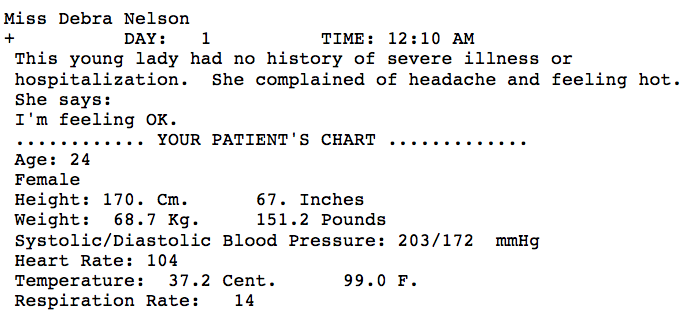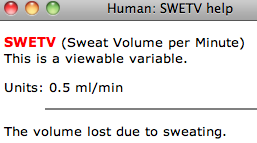Case - Headache, feeling hot, severe hypertension
Hints page 1
I. The Case (& preliminary "hints")
Case - Headache, feeling hot, severe hypertension
II. The Chart
We examine the information revealed in HUMAN by selecting < Your Patient's Chart > ...

... noting in it
• "severe hypertension" [ systolic = 203 mmHg and diastolic = 172 mm Hg ] ! and
• a tachycardia [heart rate = 104] and
• a report of "feeling hot" but no fever [ 99.0 °F ]
III. Output data tables
Investigating the statement "feeling hot" more fully, we inquire as to whether the patient sometimes sweats.
We can accomplish this query in HUMAN via
- running the patient for 10 more minutes while monitoring the values of the 3 sweat-related variables.
- These are sweat volume, calories dissipated by sweating and sodium loss via sweating.
- comparing Miss Nelson's values with baseline resting values in a 'normal' patient.
A] to obtain sweat values
The View Output: setup for such a run is shown directly below with the 3 sweat-related in Table columns 4-6.

The output of one such 10 minute run is seen below:

Thus the patient's current sweat volume (SWETV) is 0.842 ml/min.
B] to compare sweat values
We can compare this SWETV value to the normal sweat volume value via using the Help section (below, left) to "look up" the normal resting value for sweat volume (below, right).
We therefore observe that sweat volume is better than 50% elevated (0.50 -> 0.2) in this patient.
Thus to the the hypertension and tachycardia findings we can now also add that "feeing hot" is also accompanied by increased sweating.
IV. Other
The finding that the patient is sweating can be further bolstered by repeating the sequence above to verify that
• calories lost via sweating (SWETC) and
• sodium lost via sweating (SWETNA) are also elevated above normal.
V. More
This ends the hints section, part 1, on this case.
You should attempt again at this point to arrive at a diagnosis and, where possible, a treatment. To do so
• Return to the HUMAN model's Physiology Lab section for this patient and verify
- the diagnosis by finding the appropriate variables to support your argument and
- the treatment by changing parameters so as to stabilize the patient.
V. Hints section, part 2
If you wish further hints on this case click the link to the right [ second hint page ]
VI. Analysis
If you wish further analysis and a diagnosis on
this case and information on how it was created, click on this link ( analysis ) and log in as requested.
* Note: Case hints and analyses are based heavily on Drs. Randall and Coleman's HUMAN-80 Instructor's Manual supplemented by notes of Dr. Coleman's in the model code itself and findings by myself and other colleagues over our years of use of these cases.




